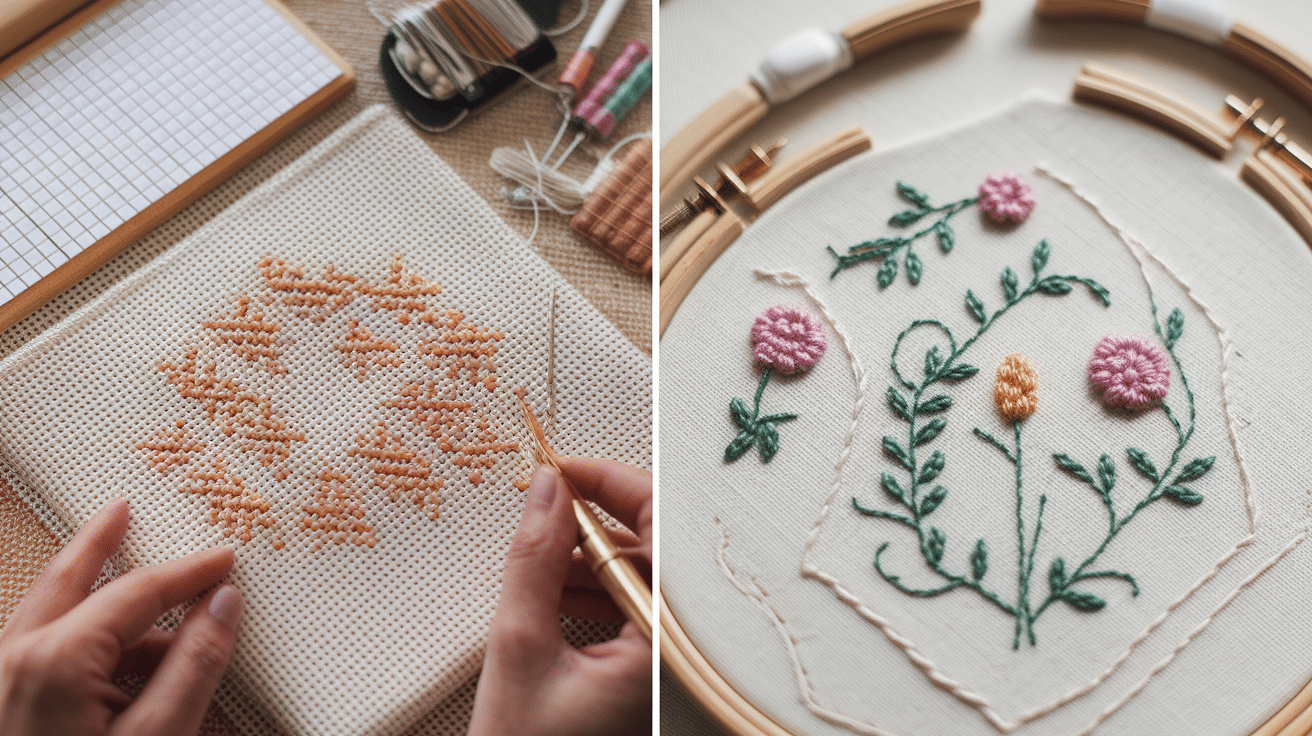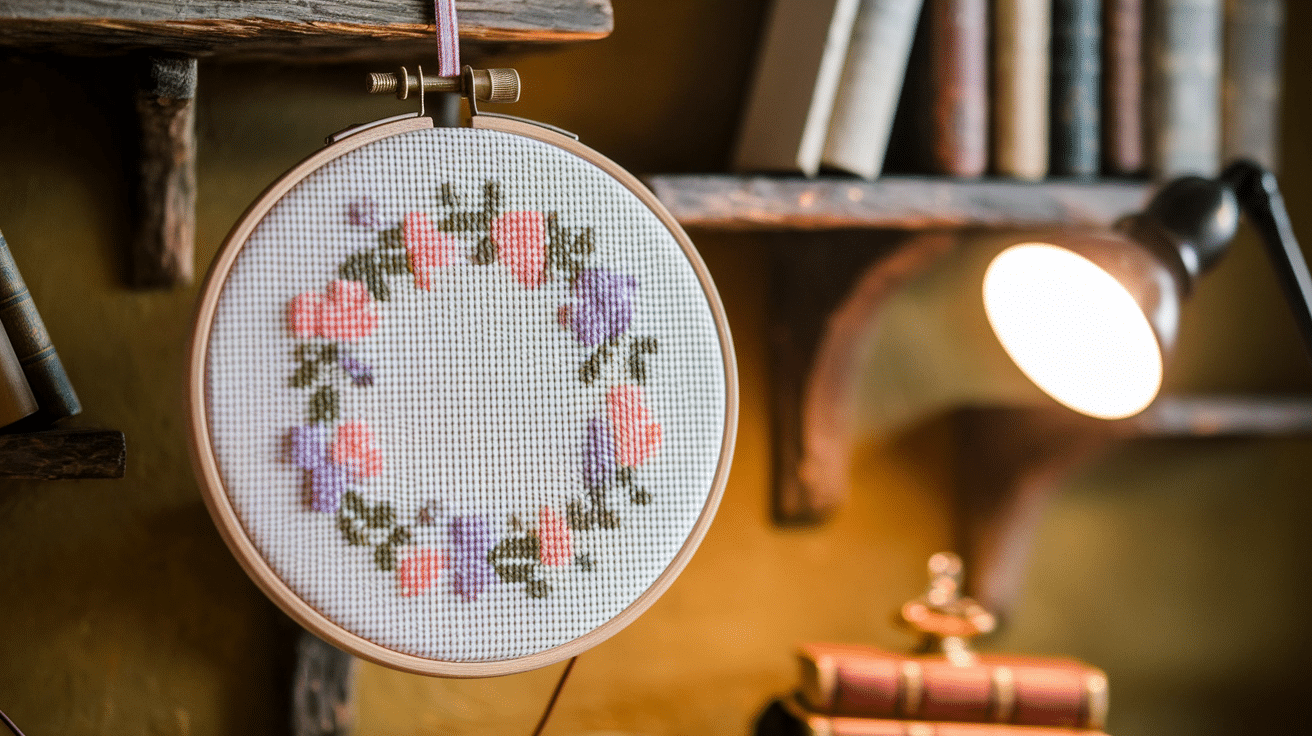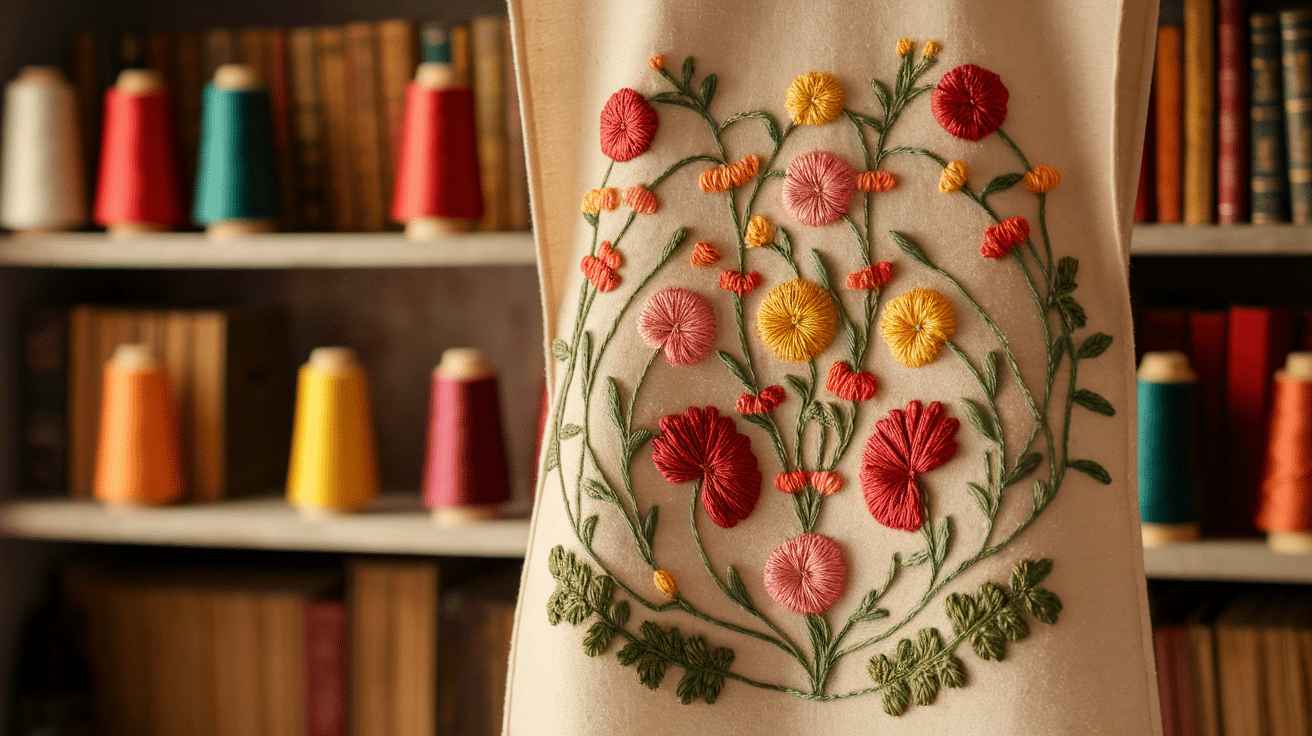Confused about needle crafts? You’re not alone. Many crafters mix up cross stitch and embroidery, missing out on choosing the right technique for their projects.
Cross stitch uses X-shaped stitches on counted fabric, while embroidery offers dozens of stitch types with more freedom. Each has its own tools, fabrics, and methods that make them unique.
Learning the differences helps you pick the best technique for your skill level and project goals. The right choice saves you time, money, and frustration.
Ready to find your perfect needle craft? This guide breaks down everything you need to know about cross stitch and embroidery—from basic supplies to finished projects—so you can start creating with confidence today.
Needle Craft Options: Basics You Need to Know
Before choosing between needle craft types, it helps to understand what makes each option unique. Needle arts come in different forms, from structured counted work to free-flowing decorative stitching. Your ideal technique depends on several factors:
- Style: Do you prefer following patterns or creating your own designs?
- Projects: What items do you want to make with your finished work?
- Patience: Are you comfortable with longer, more detailed projects?
The main choice most crafters face is between cross stitch and embroidery. This decision affects everything from the supplies you’ll need to how your finished pieces will look.
Cross stitch uses counted X-shaped stitches on special fabric, while embroidery offers many stitch types with creative freedom on almost any material. The right choice depends on your personal style, project goals, and the look you want to achieve.
Cross Stitch vs. Embroidery: Key Differences

When starting a needle craft project, knowing the differences between cross stitch and embroidery helps you select the right technique. Both arts use needle and thread to create designs on fabric, but they differ in methods, tools, and final results.
The main difference is in the stitching style. Cross stitch uses one basic X-shaped stitch on counted fabric, while embroidery offers many stitch types with more creative freedom. This key distinction affects how you approach your projects and the skills you’ll need.
Your choice should match your skill level, project goals, and personal preference. The chart below outlines the major differences to help you decide which craft fits your needs.
| Feature | Cross Stitch | Embroidery |
|---|---|---|
| Stitch Variety | Primarily X-shaped stitches on a grid pattern | Dozens of stitch types (satin, chain, French knot, etc.) with free placement |
| Fabric Requirements | Counted fabric with even weave (Aida, evenweave, linen) | Works on almost any fabric type, including both woven and non-woven materials |
| Pattern Style | Follows grid-based charts, often with symbols representing colors | Can use printed designs, drawn lines, or free-form creation |
| Skill Level | Beginner-friendly with clear rules to follow | Ranges from simple to complex depending on stitch types used |
| Tools Needed | Tapestry needles, hoops, counted fabric, pattern chart | Variety of needles, hoops/frames, transfer methods, optional tools like punch needles |
| Time Investment | Usually takes longer to complete projects due to counting | Can be faster, especially for simpler designs with fewer stitches |
| Project Uses | Best for detailed pictures, samplers, pixel-like designs | Ideal for decorative items, clothing embellishment, custom designs |
What is Cross Stitch?

Cross stitch is a counted thread technique where X-shaped stitches form patterns on evenly woven fabric. This method relies on counting threads to create precise designs from charts. Each X marks a specific spot on the grid to build the complete picture.
Cross stitch requires special fabric with uniform holes like Aida cloth or evenweave linen. The count number (14-count, 18-count) tells you how many stitches fit in one inch of fabric. Higher counts create finer, more detailed work but need more skill.
Most cross stitch projects follow printed patterns with symbols showing where each color belongs. The structured nature makes it perfect for beginners while still allowing for complex designs as skills grow.
Common Projects
- Framed Pictures: Creates wall art with quotes, scenes, or decorative motifs.
- Samplers: Showcases different patterns and often includes letters and numbers.
- Holiday Decorations: Produces ornaments, stockings, and seasonal home items.
- Bookmarks: Makes useful items with personalized designs and messages.
Ideal For
Cross stitch works best for crafters who:
- Enjoy following clear instructions and patterns
- Prefer structured, methodical crafting
- Like creating detailed, pixel-like images
- Want predictable results from their work
- Appreciate precision and counting
- Find comfort in repetitive motions
- Need a portable hobby with few tools
- Want to create gifts with a handmade touch
Pros and Cons
| Pros | Cons |
|---|---|
| Easy to learn basic technique | Limited to one main stitch type |
| Clear patterns to follow | Takes longer to complete projects |
| Mistakes are easy to fix | Less freedom for creative changes |
| Creates precise, clean designs | Requires good counting skills |
| Works well for detailed images | Relies on even, special fabrics |
| Portable with minimal tools | May feel repetitive to some |
| Predictable time requirements | Less suitable for clothing |
| Good entry point to needle arts | Pattern costs add up over time |
What is Embroidery?

Embroidery is a free-form needle art using various stitches to create designs on fabric. It offers creative freedom with dozens of stitch types, from simple running stitches to complex fills. This flexibility allows for personal expression beyond set patterns.
Unlike cross stitch, embroidery works on almost any fabric, from cotton and linen to denim and felt. The fabric doesn’t need an even weave, opening up more project possibilities. Designs can be transferred through tracing, iron-on patterns, or drawn directly.
Embroidery allows for texture, layering, and dimension that creates rich, varied results. While beginners can start with basic stitches, the craft offers room to grow with more advanced techniques over time.
Common Projects
- Clothing Embellishment: Adds personal touches to shirts, jeans, and jackets.
- Hoop Art: Displays finished work in the hoop as wall decorations.
- Home Linens: Enhances towels, pillowcases, and table cloths.
- Patches: Creates removable designs that can be attached to various items.
Ideal For
Embroidery suits crafters who:
- Value creative freedom and expression
- Enjoy learning different techniques
- Want to customize clothing and items
- Prefer a craft with room for improvisation
- Like working with color and texture
- Appreciate both modern and traditional styles
- Want to develop a skill with endless possibilities
- Enjoy working without counting or strict rules
Pros and Cons
| Pros | Cons |
|---|---|
| Offers dozens of stitch varieties | Steeper learning curve for some stitches |
| Works on nearly any fabric type | Results can be less predictable |
| Allows for creative freedom | Requires more practice for consistency |
| Creates textured, dimensional work | Some stitches are difficult to master |
| Can be quick for simple designs | Pattern transfer can be challenging |
| Versatile for many project types | Requires more different tools |
| Adapts to modern or classic styles | Mistakes can be harder to fix |
| Customizes ready-made items | Some techniques need special frames |
Final Thoughts
Both cross stitch and embroidery offer fun ways to create with needle and thread. Your choice comes down to what fits your style and goals.
Cross stitch works well if you like following clear plans and creating detailed pictures. Its structured approach makes it friendly for beginners who enjoy counting and precision.
Embroidery might be your match if you value creative options and working on different materials. Its various stitches let you express yourself more freely.
Many crafters enjoy both techniques, using each for different projects. You might start with cross stitch to learn basic skills, then try embroidery when you want more flexibility.
Whichever you choose, both crafts offer a rewarding way to make beautiful items while building skills that last a lifetime.


